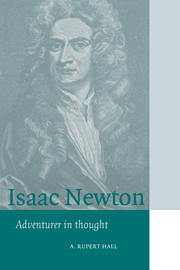Book contents
- Frontmatter
- Contents
- List of Figures
- General Editor's Preface
- Foreword
- Acknowledgement
- 1 The Hopeful Youth, 1642–1664
- 2 “The prime of my age for invention”, 1664–1667
- 3 Widening Horizons, 1667–1669
- 4 The Professor of Mathematics, 1669–1673
- 5 Publication and Polemic, 1672–1678
- 6 Life in Cambridge, 1675–1685
- 7 The Chemical Philosopher, 1669–1695
- 8 The Mathematical Principles of Natural Philosophy, 1679–1687
- 9 Private and Public life, 1685–1696
- 10 Fluxions and Fury, 1677–1712
- 11 Opticks, or a Treatise of Light, 1687–1704
- 12 Life in London, 1696–1718
- 13 A Man of Authority and Learning, 1692–1727
- 14 Later Books, 1706–1726
- 15 Kensington, 1725–1727
- Appendices
- Notes
- Bibliography
- Index
5 - Publication and Polemic, 1672–1678
Published online by Cambridge University Press: 12 January 2010
- Frontmatter
- Contents
- List of Figures
- General Editor's Preface
- Foreword
- Acknowledgement
- 1 The Hopeful Youth, 1642–1664
- 2 “The prime of my age for invention”, 1664–1667
- 3 Widening Horizons, 1667–1669
- 4 The Professor of Mathematics, 1669–1673
- 5 Publication and Polemic, 1672–1678
- 6 Life in Cambridge, 1675–1685
- 7 The Chemical Philosopher, 1669–1695
- 8 The Mathematical Principles of Natural Philosophy, 1679–1687
- 9 Private and Public life, 1685–1696
- 10 Fluxions and Fury, 1677–1712
- 11 Opticks, or a Treatise of Light, 1687–1704
- 12 Life in London, 1696–1718
- 13 A Man of Authority and Learning, 1692–1727
- 14 Later Books, 1706–1726
- 15 Kensington, 1725–1727
- Appendices
- Notes
- Bibliography
- Index
Summary
The Reflecting Telescope
The close of the year 1671 was marked by the public appearance of Newton upon the national stage of the Royal Society of London. It is strange that with both Newton and his arch-rival Leibniz this event happened in the same unexpected and unlikely way: each of them presented a gadget to the Royal Society. In Leibniz's case it was an arithmetical machine, a toothed-wheel device of the type pioneered by Blaise Pascal, in Newton's his miniature reflecting telescope. Newton's introduction to the Society (December 1671) preceded Leibniz's by just over a year. Both men were, for their pains, severely mauled by Robert Hooke, with assertions that their inventions were valueless and much inferior to his own schemes. Both were deeply wounded by this reception, though also conscious of the warmer welcome extended to them by other Fellows of the Royal Society, not least its Secretary, Henry Oldenburg.
Newton and Leibniz certainly did not meet during this first visit of Leibniz to London (January–March 1673), though before long Collins would be sharing with Leibniz an outline of the mathematical progress accomplished by James Gregory and Isaac Newton. Yet curiously there may be a link between Leibniz and Newton's reflecting telescope. In a letter that Oldenburg received probably about 20 October 1671, Leibniz (writing about the innovations made by a young German optician) mentioned ‘Tubos Catadioptricos, quales mihi in mentem venerunt’ (‘reflecting-refracting tubes, such as occurred to my mind’). No explanation of this phrase has been found, but Newton had certainly invented a catadioptrical telescope.
- Type
- Chapter
- Information
- Isaac NewtonAdventurer in Thought, pp. 116 - 142Publisher: Cambridge University PressPrint publication year: 1996

